Assessing the Impact of a Low-Emission Zone on Air Quality Using Machine Learning Algorithms in a Business-As-Usual Scenario
Abstract
:1. Introduction
2. State of the Art
3. Experimental Methods
3.1. Location of the Study
3.2. Data
3.3. Methodology
4. Results
4.1. Concentration of Pollutants in the Period 2015–2022
4.2. Validation of ML Algorithms
4.3. Effect of Madrid LEZ on the Air Quality
4.4. Analysis of Traffic Volume
5. Discussion
6. Considerations and Future Work
7. Conclusions
Supplementary Materials
Author Contributions
Funding
Institutional Review Board Statement
Informed Consent Statement
Data Availability Statement
Conflicts of Interest
References
- Manisalidis, I.; Stavropoulou, E.; Stavropoulos, A.; Bezirtzoglou, E. Environmental and Health Impacts of Air Pollution: A Review. Front. Public Health 2020, 8, 14. [Google Scholar] [CrossRef] [PubMed]
- Statista. Total Number of Declared Low-Emission Zones (LEZs) in Europe in 2022, with a Projection for 2025, by Country. 2023. Available online: https://www.statista.com/statistics/1321264/low-emission-zones-europe-by-country/ (accessed on 15 January 2024).
- Gobierno de España. Real Decreto 1052/2022, de 27 de Diciembre, por el que se Regulan las Zonas de Bajas Emisiones. 2022. Available online: https://www.boe.es/eli/es/rd/2022/12/27/1052 (accessed on 15 January 2024).
- Boogaard, H.; Janssen, N.A.; Fischer, P.H.; Kos, G.P.; Weijers, E.P.; Cassee, F.R.; van der Zee, S.C.; de Hartog, J.J.; Meliefste, K.; Wang, M.; et al. Impact of low emission zones and local traffic policies on ambient air pollution concentrations. Sci. Total Environ. 2012, 435-436, 132–140. [Google Scholar] [CrossRef] [PubMed]
- Sánchez, J.M.; Ortega, E.; López-Lambas, M.E.; Martín, B. Evaluation of emissions in traffic reduction and pedestrianization scenarios in Madrid. Transp. Res. Part D Transp. Environ. 2021, 100, 103064. [Google Scholar] [CrossRef]
- Ellison, R.B.; Greaves, S.P.; Hensher, D.A. Five years of London’s low emission zone: Effects on vehicle fleet composition and air quality. Transp. Res. Part D Transp. Environ. 2013, 23, 25–33. [Google Scholar] [CrossRef]
- Gu, J.; Deffner, V.; Küchenhoff, H.; Pickford, R.; Breitner, S.; Schneider, A.; Kowalski, M.; Peters, A.; Lutz, M.; Kerschbaumer, A.; et al. Low emission zones reduced PM10 but not NO2 concentrations in Berlin and Munich, Germany. J. Environ. Manag. 2022, 302, 114048. [Google Scholar] [CrossRef]
- Ma, L.; Graham, D.J.; Stettler, M.E.J. Has the ultra low emission zone in London improved air quality? Environ. Res. Lett. 2021, 16, 124001. [Google Scholar] [CrossRef]
- Bishop, H.F.J.; Bornioli, A. Effectiveness of London’s Ultra Low Emission Zone in Reducing Air Pollution: A Pre- and Post-Comparison of NO2 and PM10 Levels. J. Environ. Health 2021, 85, 16–23. [Google Scholar]
- Gómez-Losada, Á.; Pires, J.C. Air quality assessment during the low emission zone implementation in Madrid (Spain). Urban Clim. 2024, 55, 101995. [Google Scholar] [CrossRef]
- Rodriguez-Rey, D.; Guevara, M.; Linares, M.P.; Casanovas, J.; Armengol, J.M.; Benavides, J.; Soret, A.; Jorba, O.; Tena, C.; García-Pando, C.P. To what extent the traffic restriction policies applied in Barcelona city can improve its air quality? Sci. Total Environ. 2022, 807, 150743. [Google Scholar] [CrossRef]
- Dias, D.; Tchepel, O.; Antunes, A.P. Integrated modelling approach for the evaluation of low emission zones. J. Environ. Manag. 2016, 177, 253–263. [Google Scholar] [CrossRef]
- Holnicki, P.; Kałuszko, A.; Nahorski, Z. A Projection of Environmental Impact of a Low Emission Zone Planned in Warsaw, Poland. Sustainability 2023, 15, 16260. [Google Scholar] [CrossRef]
- Velásquez, A.R.; Guevara, M.; Armengol, J.M.; Rodríguez-Rey, D.; Mueller, N.; Cirach, M.; Khomenko, S.; Nieuwenhuijsen, M. Health impact assessment of urban and transport developments in Barcelona: A case study. Health Place 2025, 91, 103406. [Google Scholar] [CrossRef] [PubMed]
- Fabregat, A.; Vernet, A.; Vernet, M.; Vázquez, L.; Ferré, J.A. Using Machine Learning to estimate the impact of different modes of transport and traffic restriction strategies on urban air quality. Urban Clim. 2022, 45, 101284. [Google Scholar] [CrossRef]
- Ferreira, F.; Gomes, P.; Tente, H.; Carvalho, A.; Pereira, P.; Monjardino, J. Air quality improvements following implementation of Lisbon’s Low Emission Zone. Atmos. Environ. 2015, 122, 373–381. [Google Scholar] [CrossRef]
- Santos, F.M.; Gómez-Losada, Á.; Pires, J.C. Impact of the implementation of Lisbon low emission zone on air quality. J. Hazard. Mater. 2019, 365, 632–641. [Google Scholar] [CrossRef] [PubMed]
- Lebrusán, I.; Toutouh, J. Using Smart City Tools to Evaluate the Effectiveness of a Low Emissions Zone in Spain: Madrid Central. Smart Cities 2020, 3, 456–478. [Google Scholar] [CrossRef]
- Font, A.; Guiseppin, L.; Blangiardo, M.; Ghersi, V.; Fuller, G.W. A tale of two cities: Is air pollution improving in Paris and London? Environ. Pollut. 2019, 249, 1–12. [Google Scholar] [CrossRef]
- Grange, S.K.; Carslaw, D.C. Using meteorological normalisation to detect interventions in air quality time series. Sci. Total Environ. 2019, 653, 578–588. [Google Scholar] [CrossRef]
- Hajmohammadi, H.; Heydecker, B. Evaluation of air quality effects of the London ultra-low emission zone by state-space modelling. Atmos. Pollut. Res. 2022, 13, 101514. [Google Scholar] [CrossRef]
- Park, D.; Tarui, N. The Effect of Diesel Vehicle Regulation on Air Quality in Seoul: Evidence from Seoul’s Low Emission Zone. Sustainability 2024, 16, 9573. [Google Scholar] [CrossRef]
- Rybarczyk, Y.; Zalakeviciute, R. Regression Models to Predict Air Pollution from Affordable Data Collections; IntechOpen: Rijeka, Croatia, 2017; Chapter 2. [Google Scholar] [CrossRef]
- Salas, R.; Perez-Villadoniga, M.J.; Prieto-Rodriguez, J.; Russo, A. Were traffic restrictions in Madrid effective at reducing NO2 levels? Transp. Res. Part D Transp. Environ. 2021, 91, 102689. [Google Scholar] [CrossRef]
- Zhai, M.; Wolff, H. Air pollution and urban road transport: Evidence from the world’s largest low-emission zone in London. Environ. Econ. Policy Stud. 2021, 23, 721–748. [Google Scholar] [CrossRef]
- Prieto-Rodriguez, J.; Perez-Villadoniga, M.J.; Salas, R.; Russo, A. Impact of London Toxicity Charge and Ultra Low Emission Zone on NO2. Transp. Policy 2022, 129, 237–247. [Google Scholar] [CrossRef]
- Park, D.; Lim, B.I. The effect of the ultra-low emission zone on PM2.5 concentration in Seoul, South Korea. Atmos. Environ. 2025, 340, 120908. [Google Scholar] [CrossRef]
- Du, M.; Zhang, J.; Hou, X. Decarbonization like China: How does green finance reform and innovation enhance carbon emission efficiency? J. Environ. Manag. 2025, 376, 124331. [Google Scholar] [CrossRef] [PubMed]
- Apte, J.S.; Messier, K.P.; Gani, S.; Brauer, M.; Kirchstetter, T.W.; Lunden, M.M.; Marshall, J.D.; Portier, C.J.; Vermeulen, R.C.; Hamburg, S.P. High-Resolution Air Pollution Mapping with Google Street View Cars: Exploiting Big Data. Environ. Sci. Technol. 2017, 51, 6999–7008. [Google Scholar] [CrossRef] [PubMed]
- Moral-Carcedo, J. Dissuasive effect of low emission zones on traffic: The case of Madrid Central. Transportation 2022, 51, 25–49. [Google Scholar] [CrossRef]
- Lurkin, V.; Hambuckers, J.; van Woensel, T. Urban low emissions zones: A behavioral operations management perspective. Transp. Res. Part A Policy Pract. 2021, 144, 222–240. [Google Scholar] [CrossRef]
- Ceccato, R.; Rossi, R.; Gastaldi, M. Low emission zone and mobility behavior: Ex-ante evaluation of vehicle pollutant emissions. Transp. Res. Part A Policy Pract. 2024, 185, 104101. [Google Scholar] [CrossRef]
- Gonzalez, J.N.; Gomez, J.; Vassallo, J.M. Are low emission zones and on-street parking management effective in reducing parking demand for most polluting vehicles and promoting greener ones? Transp. Res. Part A Policy Pract. 2023, 176, 103813. [Google Scholar] [CrossRef]
- Lee, M.; Lin, L.; Chen, C.Y.; Tsao, Y.; Yao, T.H.; Fei, M.H.; Fang, S.H. Forecasting Air Quality in Taiwan by Using Machine Learning. Sci. Rep. 2020, 10, 4153. [Google Scholar] [CrossRef] [PubMed]
- Liu, Y.; Wang, P.; Li, Y.; Wen, L.; Deng, X. Air quality prediction models based on meteorological factors and real-time data of industrial waste gas. Sci. Rep. 2022, 12, 9253. [Google Scholar] [CrossRef] [PubMed]
- Samad, A.; Garuda, S.; Vogt, U.; Yang, B. Air pollution prediction using machine learning techniques—An approach to replace existing monitoring stations with virtual monitoring stations. Atmos. Environ. 2023, 310, 119987. [Google Scholar] [CrossRef]
- Kumar, K.; Pande, B. Air pollution prediction with machine learning: A case study of Indian cities. Int. J. Environ. Sci. Technol. 2023, 20, 5333–5348. [Google Scholar] [CrossRef]
- Ravindiran, G.; Hayder, G.; Kanagarathinam, K.; Alagumalai, A.; Sonne, C. Air quality prediction by machine learning models: A predictive study on the indian coastal city of Visakhapatnam. Chemosphere 2023, 338, 139518. [Google Scholar] [CrossRef]
- Long, Q.; Ma, J.; Guo, C.; Wang, M.; Wang, Q. High-resolution spatio-temporal estimation of street-level air pollution using mobile monitoring and machine learning. J. Environ. Manag. 2025, 377, 124642. [Google Scholar] [CrossRef]
- Fundación para el Fomento de la Innovación Industrial. Inventario de Emisiones de Contaminantes a la Atmósfera en el Municipio de Madrid 2021. 2023. Available online: https://www.madrid.es/UnidadesDescentralizadas/Sostenibilidad/EspeInf/AccionClimatica/2EstudiosInventarios/4aInventario/ficheros/AYTOMAD_InventarioConaminantes_19-22.pdf (accessed on 15 April 2025).
- Tapiador, L.; Gomez, J.; Vassallo, J.M. Exploring the relationship between public transport use and COVID-19 infection: A survey data analysis in Madrid Region. Sustain. Cities Soc. 2024, 104, 105279. [Google Scholar] [CrossRef]
- Ayuntamiento de Madrid. Estudio de la Movilidad de la Ciudad de Madrid 2022. 2024. Available online: https://transparencia.madrid.es/FWProjects/transparencia/Movilidad/Trafico/InformesMovilidad/Ficheros/InformeAnual2022.pdf (accessed on 7 October 2024).
- MADRID. Available online: https://www.madrid360.es/ (accessed on 15 December 2024).
- Grange, S.K. Technical Note: Saqgetr R Package; 2019. Available online: https://drive.google.com/open?id=1IgDODHqBHewCTKLdAAxRyR7ml8ht6Ods (accessed on 10 October 2024).
- R Core Team. R: A Language and Environment for Statistical Computing; R Foundation for Statistical Computing: Vienna, Austria, 2024. [Google Scholar]
- Kang, C.; Ota, M.; Ushijima, K. Benefits of diesel emission regulations: Evidence from the World’s largest low emission zone. J. Environ. Econ. Manag. 2024, 125, 102944. [Google Scholar] [CrossRef]
- Gobierno de España. Tendencias de la Calidad del Aire en España 2001–2021. 2023. Available online: https://www.miteco.gob.es/content/dam/miteco/es/calidad-y-evaluacion-ambiental/temas/atmosfera-y-calidad-del-aire/analisisdetendenciasdelosprincipalescontaminantesatmosfericos_tcm30-561228.pdf (accessed on 17 November 2024).
- Ayuntamiento de Madrid. Red de Estaciones Fijas de Control de Calidad del Aire. 2023. Available online: https://www.madrid.es/portales/munimadrid/es/Inicio/Medio-ambiente/Direcciones-y-telefonos/Red-de-estaciones-fijas-de-control-de-calidad-del-aire/?vgnextfmt=default&vgnextoid=aeca16d591bbf710VgnVCM2000001f4a900aRCRD&vgnextchannel=864f79ed268fe410VgnVCM1000000b205a0aRCRD (accessed on 20 July 2023).
- European Union. Directive 2008/50/EC of the European Parliament and of the Council of 21 May 2008 on Ambient Air Quality and Cleaner Air for Europe. 2008. Available online: https://eur-lex.europa.eu/legal-content/EN/TXT/PDF/?uri=CELEX:32008L0050&from=en (accessed on 20 March 2025).
- González-Pardo, J.; Ceballos-Santos, S.; Manzanas, R.; Santibáñez, M.; Fernández-Olmo, I. Estimating changes in air pollutant levels due to COVID-19 lockdown measures based on a business-as-usual prediction scenario using data mining models: A case-study for urban traffic sites in Spain. Sci. Total Environ. 2022, 823, 153786. [Google Scholar] [CrossRef]
- Breiman, L. Random Forests. Mach. Learn. 2001, 45, 5–32. [Google Scholar] [CrossRef]
- Wright, M.N.; Ziegler, A. Ranger: A Fast Implementation of Random Forests for High Dimensional Data in C++ and R. J. Stat. Softw. 2017, 77, 1–17. [Google Scholar] [CrossRef]
- Musa, A.B. Comparative study on classification performance between support vector machine and logistic regression. Int. J. Mach. Learn. Cybern. 2013, 4, 13–24. [Google Scholar] [CrossRef]
- Madan, T.; Sagar, S.; Virmani, D. Air Quality Prediction using Machine Learning Algorithms—A Review. In Proceedings of the 2020 2nd International Conference on Advances in Computing, Communication Control and Networking (ICACCCN), Greater Noida, India, 18–19 December 2020; pp. 140–145. [Google Scholar] [CrossRef]
- Liang, Y.C.; Maimury, Y.; Chen, A.H.L.; Juarez, J.R.C. Machine Learning-Based Prediction of Air Quality. Appl. Sci. 2020, 10, 9151. [Google Scholar] [CrossRef]
- Iskandaryan, D.; Ramos, F.; Trilles, S. Air Quality Prediction in Smart Cities Using Machine Learning Technologies Based on Sensor Data: A Review. Appl. Sci. 2020, 10, 2401. [Google Scholar] [CrossRef]
- Lei, T.M.T.; Siu, S.W.I.; Monjardino, J.; Mendes, L.; Ferreira, F. Using Machine Learning Methods to Forecast Air Quality: A Case Study in Macao. Atmosphere 2022, 13, 1412. [Google Scholar] [CrossRef]
- Martínez-España, R.; Bueno-Crespo, A.; Timón, I.; Soto, J.; Muñoz, A.; Cecilia, J.M. Air-Pollution Prediction in Smart Cities through Machine Learning Methods: A Case of Study in Murcia, Spain. JUCS—J. Univers. Comput. Sci. 2018, 24, 261–276. [Google Scholar] [CrossRef]
- Mogollón-Sotelo, C.; Casallas, A.; Vidal, S.; Celis, N.; Ferro, C.; Belalcazar, L. A support vector machine model to forecast ground-level PM2.5 in a highly populated city with a complex terrain. Air Qual. Atmos. Health 2021, 14, 300–409. [Google Scholar] [CrossRef]
- Chelani, A.B. Prediction of daily maximum ground ozone concentration using support vector machine. Environ. Monit. Assess. 2010, 162, 169–176. [Google Scholar] [CrossRef]
- Barbalat, G.; Hough, I.; Dorman, M.; Lepeule, J.; Kloog, I. A multi-resolution ensemble model of three decision-tree-based algorithms to predict daily NO2 concentration in France 2005–2022. Environ. Res. 2024, 257, 119241. [Google Scholar] [CrossRef]
- Borchers-Arriagada, N.; Morgan, G.G.; Van Buskirk, J.; Gopi, K.; Yuen, C.; Johnston, F.H.; Guo, Y.; Cope, M.; Hanigan, I.C. Daily PM2.5 and Seasonal-Trend Decomposition to Identify Extreme Air Pollution Events from 2001 to 2020 for Continental Australia Using a Random Forest Model. Atmosphere 2024, 15, 1341. [Google Scholar] [CrossRef]
- Liaw, A.; Wiener, M. Classification and Regression by randomForest. R News 2002, 2, 18–22. [Google Scholar]
- Meyer, D.; Dimitriadou, E.; Hornik, K.; Weingessel, A.; Leisch, F. e1071: Misc Functions of the Department of Statistics, Probability Theory Group (Formerly: E1071), TU Wien; R package version 1.7-12; 2022. Available online: https://CRAN.R-project.org/package=e1071 (accessed on 10 October 2024).
- Mondal, S.; Adhikary, A.S.; Dutta, A.; Bhardwaj, R.; Dey, S. Utilizing Machine Learning for air pollution prediction, comprehensive impact assessment, and effective solutions in Kolkata, India. Results Earth Sci. 2024, 2, 100030. [Google Scholar] [CrossRef]
- Matthaios, V.N.; Knibbs, L.D.; Kramer, L.J.; Crilley, L.R.; Bloss, W.J. Predicting real-time within-vehicle air pollution exposure with mass-balance and machine learning approaches using on-road and air quality data. Atmos. Environ. 2024, 318, 120233. [Google Scholar] [CrossRef]
- Makhdoomi, A.; Sarkhosh, M.; Ziaei, S. PM(2.5) concentration prediction using machine learning algorithms: An approach to virtual monitoring stations. Sci. Rep. 2025, 15, 8076. [Google Scholar] [CrossRef]
- Gobierno de España. Episodios Actualizados Hasta 31 de Diciembre de 2022. 2023. Available online: https://www.miteco.gob.es/content/dam/miteco/es/calidad-y-evaluacion-ambiental/temas/atmosfera-y-calidad-del-aire/episodios_actualizados_hasta_el31dediciembre_de_2022_tcm30-550131.pdf (accessed on 13 November 2024).
- Psistaki, K.; Richardson, D.; Achilleos, S.; Roantree, M.; Paschalidou, A.K. Assessing the Impact of Climatic Factors and Air Pollutants on Cardiovascular Mortality in the Eastern Mediterranean Using Machine Learning Models. Atmosphere 2025, 16, 325. [Google Scholar] [CrossRef]
- Zhang, Z.; Johansson, C.; Engardt, M.; Stafoggia, M.; Ma, X. Improving 3-day deterministic air pollution forecasts using machine learning algorithms. Atmos. Chem. Phys. 2024, 24, 807–851. [Google Scholar] [CrossRef]
- Tarriño-Ortiz, J.; Gómez, J.; Soria-Lara, J.A.; Vassallo, J.M. Analyzing the impact of Low Emission Zones on modal shift. Sustain. Cities Soc. 2022, 77, 103562. [Google Scholar] [CrossRef]
- Viana, M.; de Leeuw, F.; Bartonova, A.; Castell, N.; Ozturk, E.; González Ortiz, A. Air quality mitigation in European cities: Status and challenges ahead. Environ. Int. 2020, 143, 105907. [Google Scholar] [CrossRef] [PubMed]
- Hernández-Tamurejo, J.; Rodríguez Herráez, B.; Mora Agudo, M.L. Telework and the limited impact on traffic reduction—Case study Madrid (Spain). Acta Logist. 2023, 10, 423–434. [Google Scholar] [CrossRef]
- Bañuelos-Gimeno, J.; Sobrino, N.; Arce-Ruiz, R. Initial Insights into Teleworking’s Effect on Air Quality in Madrid City. Environments 2024, 11, 204. [Google Scholar] [CrossRef]
- Wang, Q.; Gu, J.; Wang, X. The impact of Sahara dust on air quality and public health in European countries. Atmos. Environ. 2020, 241, 117771. [Google Scholar] [CrossRef]
- Lotrecchiano, N.; Capozzi, V.; Sofia, D. An Innovative Approach to Determining the Contribution of Saharan Dust to Pollution. Int. J. Environ. Res. Public Health 2021, 18, 6100. [Google Scholar] [CrossRef] [PubMed]
- Lenschow, P.; Abraham, H.J.; Kutzner, K.; Lutz, M.; Preuß, J.D.; Reichenbächer, W. Some ideas about the sources of PM10. Atmos. Environ. 2001, 35, S23–S33. [Google Scholar] [CrossRef]
- Diapouli, E.; Manousakas, M.I.; Vratolis, S.; Vasilatou, V.; Pateraki, S.; Bairachtari, K.A.; Querol, X.; Amato, F.; Alastuey, A.; Karanasiou, A.A.; et al. AIRUSE-LIFE+: Estimation of natural source contributions to urban ambient air PM10 and PM2.5 concentrations in southern Europe – implications to compliance with limit values. Atmos. Chem. Phys. 2017, 17, 3673–3685. [Google Scholar] [CrossRef]
- Santiago, J.; Rivas, E.; Sánchez, B.; Vivanco, M.; Theobald, M.; Garrido, J.; Gil, V.; Buccolieri, R.; Martilli, A.; Rodríguez-Sánchez, A.; et al. How do emission reductions of individual national and local measures impact street-level air quality in a neighbourhood of Madrid, Spain? Air Qual. Atmos. Health 2024, 17, 813–826. [Google Scholar] [CrossRef]


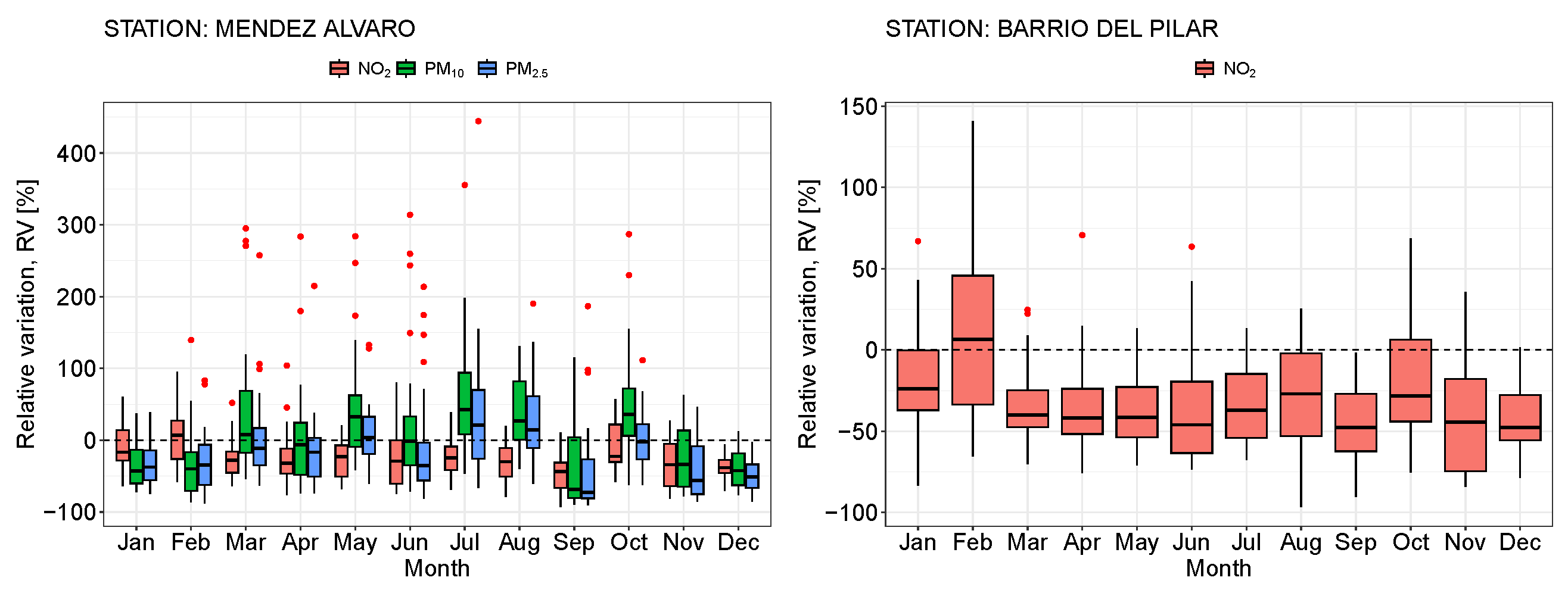
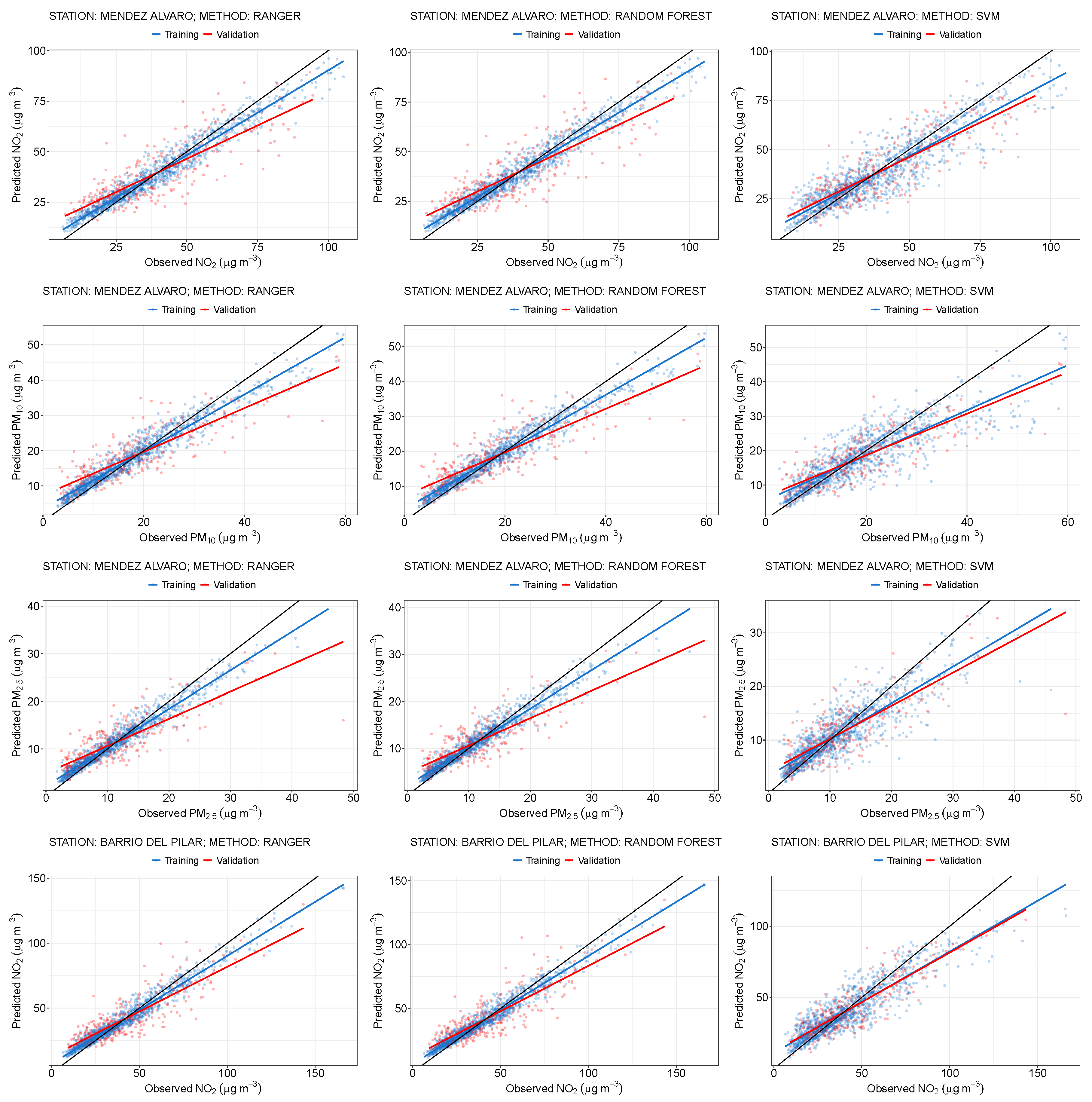
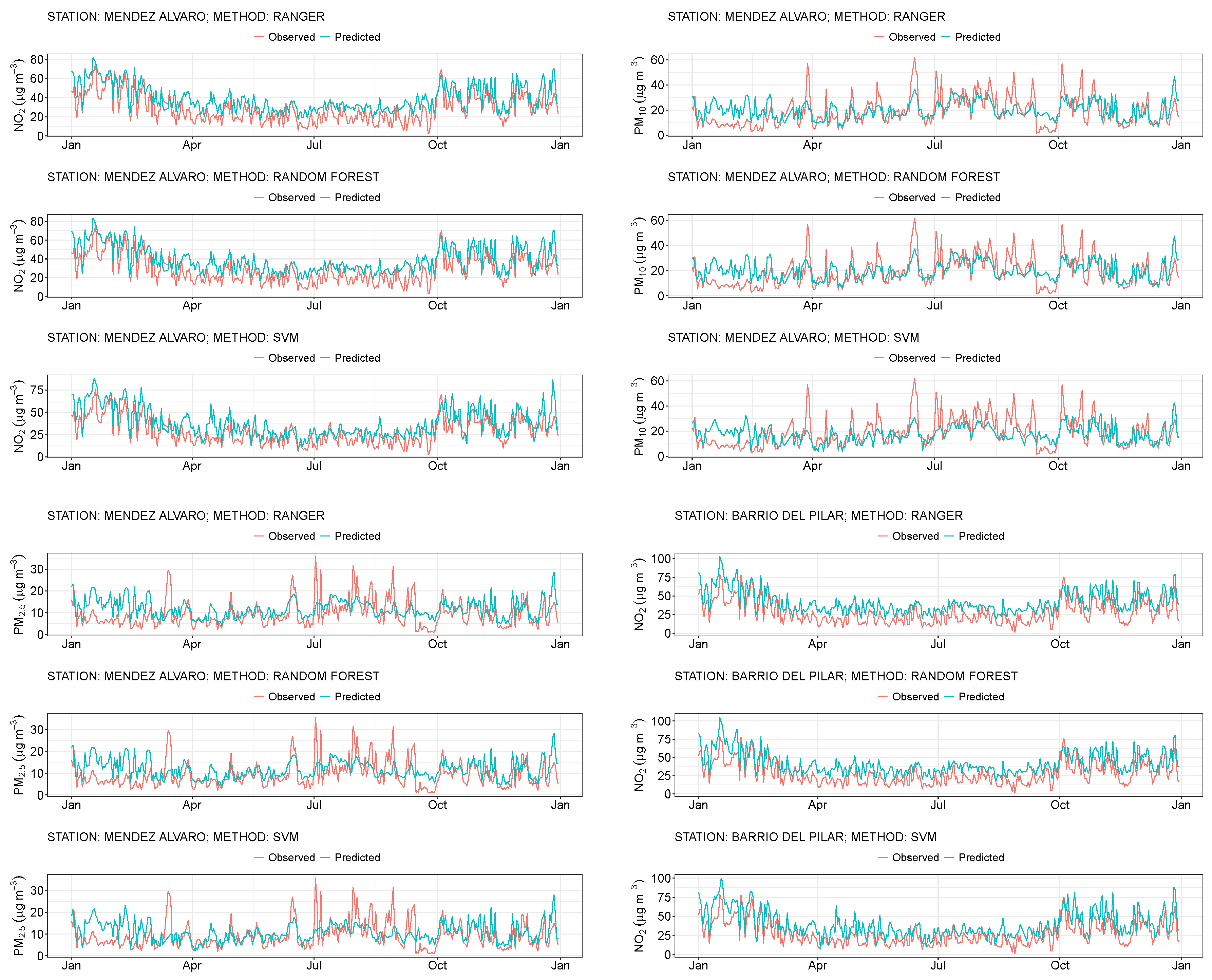
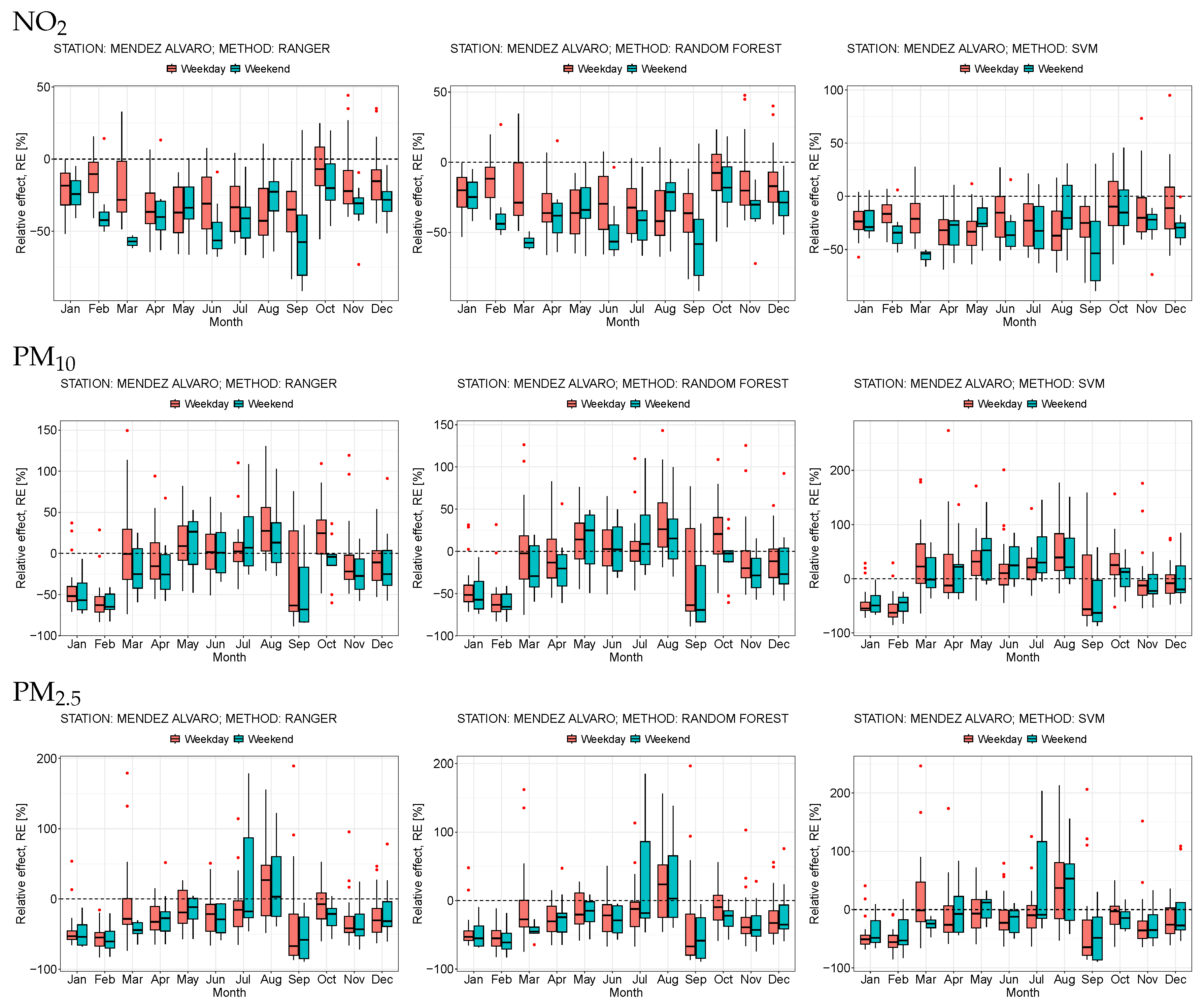

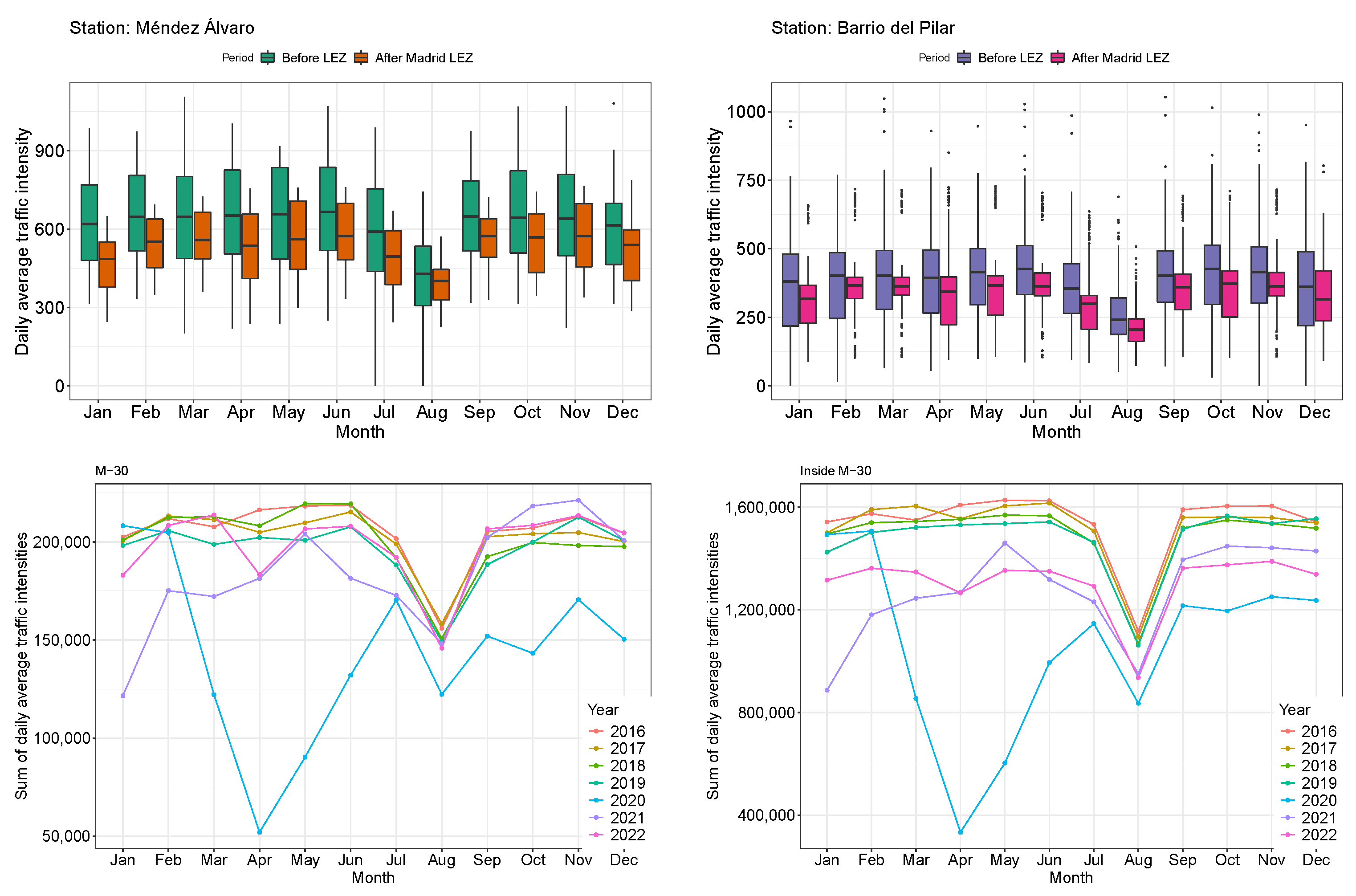

| Station | Urban Site | Pollutants | Considered in the Study |
|---|---|---|---|
| Barrio del Pilar | Traffic | NOx, O3 | √ |
| Castellana | Traffic | NOx, PM10, PM2.5 | × |
| Cuatro Caminos | Traffic | NOx, PM10, PM2.5, BTX | × |
| Escuelas Aguirre | Traffic | NOx, SO2, CO, PM10, PM2.5, O3, BTX | √ |
| Méndez Álvaro | Background | NOx, PM10, PM2.5 | √ |
| Plaza de Castilla | Traffic | NOx, PM10, PM2.5 | × |
| Plaza de España | Traffic | NOx, SO2, CO | × |
| Plaza del Carmen | Background | NOx, SO2, CO, O3 | √ |
| Ramón y Cajal | Traffic | NOx, BTX | √ |
| Retiro | Background | NOx, O3 | √ |
| Méndez Álvaro Station | ||||||
| Polluant | Model | Set | MAE () | MAPE | RMSE () | |
| NO2 | RF | Training | 3.58 | 0.12 | 4.61 | 0.96 |
| Ranger | Training | 3.73 | 0.13 | 4.79 | 0.95 | |
| SVM | Training | 6.18 | 0.20 | 8.51 | 0.82 | |
| RF | Validation | 8.38 | 0.26 | 10.60 | 0.68 | |
| Ranger | Validation | 8.41 | 0.26 | 10.62 | 0.68 | |
| SVM | Validation | 7.93 | 0.24 | 10.17 | 0.71 | |
| PM10 | RF | Training | 2.04 | 0.13 | 2.82 | 0.94 |
| Ranger | Training | 2.10 | 0.14 | 2.91 | 0.94 | |
| SVM | Training | 3.56 | 0.21 | 5.48 | 0.74 | |
| RF | Validation | 4.29 | 0.32 | 5.64 | 0.70 | |
| Ranger | Validation | 4.28 | 0.32 | 5.62 | 0.71 | |
| SVM | Validation | 4.20 | 0.29 | 5.81 | 0.69 | |
| PM2.5 | RF | Training | 1.25 | 0.14 | 1.77 | 0.94 |
| Ranger | Training | 1.29 | 0.14 | 1.81 | 0.94 | |
| SVM | Training | 2.23 | 0.23 | 3.35 | 0.74 | |
| RF | Validation | 2.85 | 0.32 | 3.95 | 0.65 | |
| Ranger | Validation | 2.85 | 0.33 | 4.00 | 0.65 | |
| SVM | Validation | 2.76 | 0.31 | 4.03 | 0.63 | |
| Barrio del Pilar Station | ||||||
| Polluant | Model | Set | MAE () | MAPE | RMSE () | |
| NO2 | RF | Training | 4.07 | 0.13 | 5.39 | 0.96 |
| Ranger | Training | 4.25 | 0.13 | 5.62 | 0.96 | |
| SVM | Training | 7.29 | 0.21 | 10.32 | 0.81 | |
| RF | Validation | 9.36 | 0.26 | 11.88 | 0.70 | |
| Ranger | Validation | 9.28 | 0.26 | 11.80 | 0.71 | |
| SVM | Validation | 8.56 | 0.23 | 11.13 | 0.74 | |
| Méndez Álvaro Station | ||||||||
| Polluant | Model | Mean | Sd | Min | Max | Q1 | Q2 | Q3 |
| NO2 | RF | −27.23 | 23.40 | −91.76 | 47.66 | −42.65 | −29.72 | −11.08 |
| Ranger | −27.29 | 23.03 | −91.47 | 44.19 | −42.78 | −29.78 | −11.48 | |
| SVM | −22.85 | 25.34 | −89.04 | 94.87 | −38.79 | −25.95 | −8.21 | |
| PM10 | RF | −7.50 | 44.91 | −88.51 | 143.18 | −42.13 | −10.19 | 19.92 |
| Ranger | −7.40 | 45.00 | −88.50 | 149.51 | −41.82 | −10.39 | 21.56 | |
| SVM | 8.68 | 58.21 | −87.52 | 273.48 | −33.07 | 0.51 | 37.47 | |
| PM2.5 | RF | −20.59 | 45.55 | −89.29 | 196.65 | −50.51 | −30.83 | −4.60 |
| Ranger | −20.74 | 45.19 | −89.32 | 189.42 | −49.92 | −30.64 | −4.85 | |
| SVM | −9.71 | 54.38 | −89.23 | 246.18 | −46.61 | −20.66 | 9.30 | |
| Barrrio del Pilar Station | ||||||||
| Polluant | Model | Mean | Sd | Min | Max | Q1 | Q2 | Q3 |
| NO2 | RF | −34.96 | 21.13 | −94.58 | 38.83 | −50.10 | −36.67 | −20.77 |
| Ranger | −34.98 | 21.29 | −94.42 | 34.58 | −50.99 | −36.06 | −20.22 | |
| SVM | −29.25 | 24.63 | −93.95 | 78.22 | −45.70 | −31.21 | −15.11 | |
Disclaimer/Publisher’s Note: The statements, opinions and data contained in all publications are solely those of the individual author(s) and contributor(s) and not of MDPI and/or the editor(s). MDPI and/or the editor(s) disclaim responsibility for any injury to people or property resulting from any ideas, methods, instructions or products referred to in the content. |
© 2025 by the authors. Licensee MDPI, Basel, Switzerland. This article is an open access article distributed under the terms and conditions of the Creative Commons Attribution (CC BY) license (https://creativecommons.org/licenses/by/4.0/).
Share and Cite
Doval-Miñarro, M.; Bueso, M.C.; Guillén-Alcaraz, P.A. Assessing the Impact of a Low-Emission Zone on Air Quality Using Machine Learning Algorithms in a Business-As-Usual Scenario. Sustainability 2025, 17, 3582. https://doi.org/10.3390/su17083582
Doval-Miñarro M, Bueso MC, Guillén-Alcaraz PA. Assessing the Impact of a Low-Emission Zone on Air Quality Using Machine Learning Algorithms in a Business-As-Usual Scenario. Sustainability. 2025; 17(8):3582. https://doi.org/10.3390/su17083582
Chicago/Turabian StyleDoval-Miñarro, Marta, María C. Bueso, and Pedro Antonio Guillén-Alcaraz. 2025. "Assessing the Impact of a Low-Emission Zone on Air Quality Using Machine Learning Algorithms in a Business-As-Usual Scenario" Sustainability 17, no. 8: 3582. https://doi.org/10.3390/su17083582
APA StyleDoval-Miñarro, M., Bueso, M. C., & Guillén-Alcaraz, P. A. (2025). Assessing the Impact of a Low-Emission Zone on Air Quality Using Machine Learning Algorithms in a Business-As-Usual Scenario. Sustainability, 17(8), 3582. https://doi.org/10.3390/su17083582










